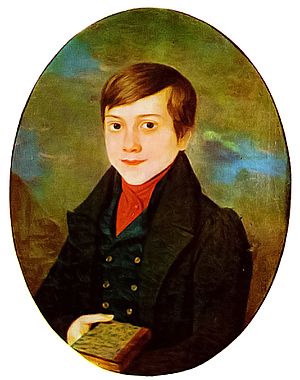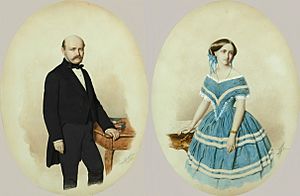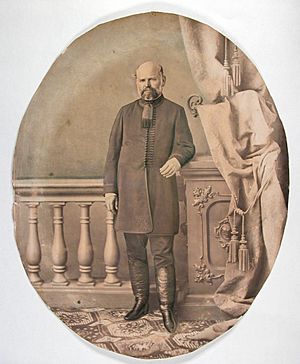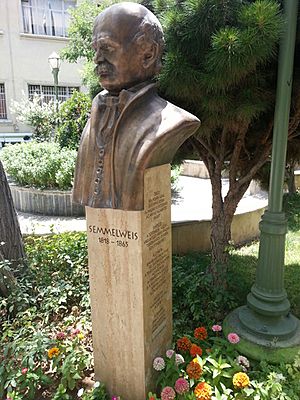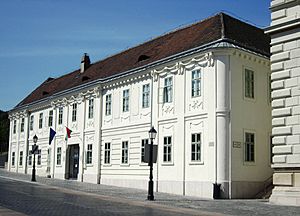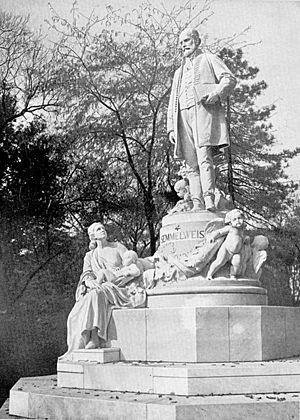Ignaz Semmelweis facts for kids
Quick facts for kids
Ignaz Semmelweis
|
|
|---|---|
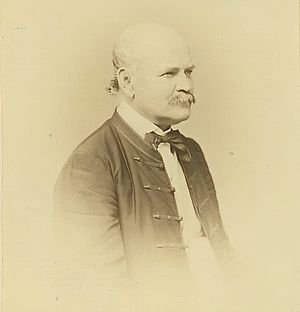
Dr. Ignaz Semmelweis, aged 42 in 1860, photograph by Borsos és Doctor
|
|
| Born |
Semmelweis Ignác Fülöp
1 July 1818 |
| Died | 13 August 1865 (aged 47) Oberdöbling, Austrian Empire (now Vienna, Austria)
|
| Citizenship | Kingdom of Hungary |
| Alma mater | University of Vienna |
| Known for | Introducing hand disinfection standards, in obstetrical clinics, from 1847 |
| Scientific career | |
| Fields | Obstetrics, surgeries |
| Spouse(s) |
Mária Weidenhofer
(m. 1857) |
| Children | 5 |
Ignaz Philipp Semmelweis (German: [ˈɪɡnaːts ˈzɛml̩vaɪs]; Hungarian: Semmelweis Ignác Fülöp [ˈsɛmmɛlvɛjs ˈiɡnaːts ˈfyløp]; 1 July 1818 – 13 August 1865) was a Hungarian physician and scientist, who was an early pioneer of antiseptic procedures. Described as the "saviour of mothers", he discovered that the incidence of puerperal fever (also known as "childbed fever") could be drastically reduced by requiring hand disinfection in obstetrical clinics. Puerperal fever was common in mid-19th-century hospitals and often fatal. He proposed the practice of washing hands with chlorinated lime solutions in 1847 while working in Vienna General Hospital's First Obstetrical Clinic, where doctors' wards had three times the mortality of midwives' wards. He published a book of his findings in Etiology, Concept and Prophylaxis of Childbed Fever.
Despite various publications of results where hand-washing reduced mortality to below 1%, Semmelweis's observations conflicted with the established scientific and medical opinions of the time and his ideas were rejected by the medical community. He could offer no theoretical explanation for his findings of reduced mortality due to hand-washing, and some doctors were offended at the suggestion that they should wash their hands and mocked him for it. In 1865, the increasingly outspoken Semmelweis allegedly suffered a nervous breakdown and was committed to an asylum by his colleagues. In the asylum he was beaten by the guards. He died 14 days later from a gangrenous wound on his right hand that may have been caused by the beating. His findings earned widespread acceptance only years after his death, when Louis Pasteur confirmed the germ theory, giving Semmelweis' observations a theoretical explanation, and Joseph Lister, acting on Pasteur's research, practised and operated using hygienic methods, with great success.
Contents
Family and early life
Ignaz Semmelweis was born on 1 July 1818 in the Tabán neighbourhood of Buda, Kingdom of Hungary, Austrian Empire. He was the fifth child out of 10 of the prosperous grocer family of József Semmelweis and Teréz Müller.
Of German ancestry, his father was an ethnic German (hienc, stem from Heanzenland, a German term for the historical Western-Hungary) born in Kismarton, then in the Kingdom of Hungary (now Eisenstadt, Austria), and his mother an ethnic German from Buda. He was granted citizenship in Buda in 1806 and, in the same year, he opened a wholesale business for spices and general consumer goods. The company was named Zum weißen Elefanten (At the White Elephant) in the Meindl House (today's Semmelweis Museum of Medical History, located at 1–3 Apród Street, Budapest). By 1810, he was a wealthy man and married Teréz Müller, daughter of the coachbuilder Fülöp Müller.
Ignaz began studying law at the University of Vienna in the autumn of 1837, but by the following year, for reasons that are no longer known, he had switched to medicine. He was awarded his doctor of medicine degree in 1844. Later, after failing to obtain an appointment in a clinic for internal medicine, Semmelweis decided to specialize in obstetrics. His teachers included Carl von Rokitansky, Joseph Škoda, and Ferdinand von Hebra.
Work on cause of childbed fever mortality
Position at Vienna General Hospital
Semmelweis was appointed assistant to Professor Johann Klein in the First Obstetrical Clinic of the Vienna General Hospital on 1 July 1846. A comparable position today in a United States hospital would be "chief resident." His duties were to examine patients each morning in preparation for the professor's rounds, supervise difficult deliveries, teach students of obstetrics, and be "clerk" of records.
Two maternity clinics were at the Viennese hospital. The First Clinic had an average maternal mortality rate of about 10% due to puerperal fever. The Second Clinic's rate was considerably lower, averaging less than 4%. This fact was known outside the hospital. The two clinics admitted on alternate days, but women begged to be admitted to the Second Clinic, due to the bad reputation of the First Clinic. Semmelweis described desperate women begging on their knees not to be admitted to the First Clinic. Some women even preferred to give birth in the streets, pretending to have given sudden birth en route to the hospital (a practice known as street births), which meant they would still qualify for the child care benefits without having been admitted to the clinic. Semmelweis was puzzled that puerperal fever was rare among women giving street births. "To me, it appeared logical that patients who experienced street births would become ill at least as frequently as those who delivered in the clinic. [...] What protected those who delivered outside the clinic from these destructive unknown endemic influences?"
Efforts to reduce childbed fever
Semmelweis's hypothesis, that there was only one cause, that all that mattered was cleanliness, was extreme at the time and was largely ignored, rejected, or ridiculed. He was dismissed from the hospital for political reasons and harassed by the medical community in Vienna, being eventually forced to move to Budapest.
Semmelweis was outraged by the indifference of the medical profession and began writing open and increasingly angry letters to prominent European obstetricians, at times denouncing them as irresponsible murderers. His contemporaries, including his wife, believed he was losing his mind, and in 1865, nearly 20 years after his breakthrough, he was committed to the Landesirrenanstalt Döbling (provincial lunatic asylum). He died there of septic shock only 14 days later, possibly as the result of being severely beaten by guards. Semmelweis's practice earned widespread acceptance only years after his death when Louis Pasteur further developed the germ theory of disease, offering a theoretical explanation for Semmelweis's findings. He is considered a pioneer of antiseptic procedures.
Conflict with established medical opinion

Semmelweis's observations conflicted with the established scientific and medical opinions of the time. The theory of diseases was highly influenced by ideas of an imbalance of the basic "four humours" in the body, a theory known as dyscrasia, for which the main treatment was bloodlettings. Medical texts at the time emphasized that each case of disease was unique, the result of a personal imbalance, and the main difficulty of the medical profession was to establish precisely each patient's unique situation, case by case.
The findings from autopsies of deceased women also showed a confusing multitude of physical signs, which emphasized the belief that puerperal fever was not one, but many different, yet unidentified, diseases.
The rejection of Semmelweis's empirical observations is often traced to belief perseverance, the psychological tendency of clinging to discredited beliefs. Also, some historians of science argue that resistance to path-breaking contributions of obscure scientists is common and "constitutes the single most formidable block to scientific advances."
As a result, his ideas were rejected by the medical community. Other, more subtle, factors may also have played a role. Some doctors, for instance, were offended at the suggestion that they should wash their hands, feeling that their social status as gentlemen was inconsistent with the idea that their hands could be unclean.
Semmelweis's results lacked scientific explanation at the time. That became possible only in the 1860s and 1870s, when Louis Pasteur, Joseph Lister, and others further developed the germ theory of disease.
During 1848, Semmelweis widened the scope of his washing protocol, to include all instruments coming in contact with patients in labour, and used mortality rates time series to document his success in virtually eliminating puerperal fever from the hospital ward.
Hesitant publication of results and first signs of trouble
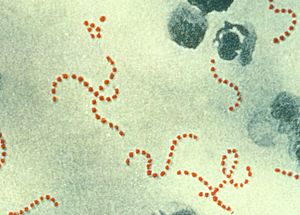
Toward the end of 1847, accounts of the work of Semmelweis (as well as the similar conclusions of Oliver Wendell Holmes Sr., working in America) began to spread around Europe. Semmelweis and his students wrote letters to the directors of several prominent maternity clinics describing their recent observations. Ferdinand von Hebra, the editor of a leading Austrian medical journal, announced Semmelweis's discovery in the December 1847 and April 1848 issues of the medical journal. Hebra claimed that Semmelweis's work had a practical significance comparable to that of Edward Jenner's introduction of cowpox inoculations to prevent smallpox.
In late 1848, one of Semmelweis's former students wrote a lecture explaining Semmelweis's work. The lecture was presented before the Royal Medical and Surgical Society in London and a review published in The Lancet, a prominent medical journal. A few months later, another of Semmelweis's former students published a similar essay in a French periodical.
As accounts of the dramatic reduction in mortality rates in Vienna were being circulated throughout Europe, Semmelweis had reason to expect that the chlorine washings would be widely adopted, saving tens of thousands of lives. Early responses to his work also gave clear signs of coming trouble, however. Some physicians had clearly misinterpreted his claims. Additionally, initial responses to Semmelweis's findings tended to downplay their significance by arguing that he had said nothing new. James Young Simpson, for instance, saw no difference between Semmelweis's groundbreaking findings and the idea presented in an 1843 paper by Oliver Wendell Holmes Sr. that childbed fever was contagious (i.e. that infected persons could pass the infection to others).
In fact, Semmelweis was warning against all decaying organic matter, not just against a specific contagion that originated from victims of childbed fever themselves. This misunderstanding, and others like it, occurred partly because Semmelweis's work was known only through secondhand reports written by his colleagues and students. At this crucial stage, Semmelweis himself had published nothing. These and similar misinterpretations continued to cloud discussions of his work throughout the century.
Some accounts emphasize that Semmelweis refused to communicate his method officially to the learned circles of Vienna, nor was he eager to explain it on paper.
Political turmoil and dismissal from the Vienna hospital
In 1848, a series of tumultuous revolutions swept across Europe. The resulting political turmoil would affect Semmelweis's career. In Vienna on 13 March 1848, students demonstrated in favor of increased civil rights, including trial by jury and freedom of expression. The demonstrations were led by medical students and young faculty members and were joined by workers from the suburbs. Two days later in Hungary, demonstrations and uprisings led to the Hungarian Revolution of 1848 and a full-scale war against the ruling Habsburgs of the Austrian Empire. In Vienna, the March demonstration was followed by months of general unrest.
No evidence indicates Semmelweis was personally involved in the events of 1848. Some of his brothers were punished for active participation in the Hungarian independence movement, and the Hungarian-born Semmelweis likely was sympathetic to the cause. Semmelweis's superior, professor Johann Klein, was a conservative Austrian, likely uneasy with the independence movements and alarmed by the other revolutions of 1848 in the Habsburg areas. Klein probably mistrusted Semmelweis.
When Semmelweis's term was about to expire, Carl Braun also applied for the position of "assistant" in the First Clinic, possibly at Klein's own invitation. Semmelweis and Braun were the only two applicants for the post. Semmelweis's predecessor, Franz Breit, had been granted a two-year extension. Semmelweis's application for an extension was supported by Joseph Škoda and Carl von Rokitansky and by most of the medical faculty, but Klein chose Braun for the position. Semmelweis was obliged to leave the obstetrical clinic when his term expired on March 20, 1849.
The day his term expired, Semmelweis petitioned the Viennese authorities to be made docent of obstetrics. A docent was a private lecturer who taught students and who had access to some university facilities. At first, because of Klein's opposition, Semmelweis's petition was denied. He reapplied, but had to wait until 10 October 1850 (more than 18 months), before finally being appointed docent of 'theoretical' obstetrics. The terms refused him access to cadavers and limited him to teaching students by using leather-fabricated mannequins only. A few days after being notified of his appointment, Semmelweis left Vienna abruptly and returned to Pest. He apparently left without so much as saying goodbye to his former friends and colleagues, a move that might have offended them. According to his own account, he left Vienna because he was "unable to endure further frustrations in dealing with the Viennese medical establishment".
Life in Budapest
During 1848–1849, some 70,000 troops from the Habsburg-ruled Austrian Empire thwarted the Hungarian independence movement, executed or imprisoned its leaders and in the process destroyed parts of Pest. Semmelweis, upon arriving from the Habsburg Vienna in 1850, likely was not warmly welcomed in Pest.
On 20 May 1851, Semmelweis took the relatively insignificant, unpaid, honorary head-physician position of the obstetric ward of Pest's small Szent Rókus Hospital. He held that position for six years, until June 1857. Childbed fever was rampant at the clinic. After taking over in 1851, Semmelweis virtually eliminated the disease. During 1851–1855, only eight patients died from childbed fever out of 933 births (0.85%).
Despite the impressive results, Semmelweis's ideas were not accepted by the other obstetricians in Budapest. The professor of obstetrics at the University of Pest, Ede Flórián Birly, never adopted Semmelweis's methods. He continued to believe that puerperal fever was due to uncleanliness of the bowel. Therefore, extensive purging was the preferred treatment.
After Birly died in 1854, Semmelweis applied for the position. So did Carl Braun—Semmelweis's nemesis and successor as Johann Klein's assistant in Vienna—and Braun received more votes from his Hungarian colleagues than Semmelweis did. Semmelweis was eventually appointed in 1855, but only because the Viennese authorities overruled the wishes of the Hungarians, as Braun did not speak Hungarian. As professor of obstetrics, Semmelweis instituted chlorine washings at the University of Pest maternity clinic. Once again, the results were impressive.
Semmelweis declined an offer in 1857 to become professor of obstetrics at the University of Zurich. The same year, Semmelweis married Mária Weidenhofer (1837–1910), 19 years his junior and the daughter of a successful merchant in Pest. They had five children.
Breakdown and death
After a number of unfavorable foreign reviews of his 1861 book, Semmelweis lashed out against his critics in a series of open letters. They were addressed to various prominent European obstetricians, including Späth, Scanzoni, Siebold, and to "all obstetricians". They were full of bitterness, desperation, and fury and were "highly polemical and superlatively offensive", at times denouncing his critics as irresponsible murderers or ignoramuses. He also called upon Siebold to arrange a meeting of German obstetricians somewhere in Germany to provide a forum for discussions on puerperal fever, where he would stay "until all have been converted to his theory."
In mid-1865, his public behaviour became exasperating and embarrassing to his associates. On 13 July 1865, the Semmelweis family visited friends, and during the visit, Semmelweis's behavior seemed particularly inappropriate.
Semmelweis's alleged affliction has been a subject of some debate. According to K. In 1865, János Balassa wrote a document referring Semmelweis to a mental institution. On 30 July, Ferdinand Ritter von Hebra lured him, under the pretense of visiting one of Hebra's "new Institutes", to a Viennese insane asylum located in Lazarettgasse (Landes-Irren-Anstalt in der Lazarettgasse). Semmelweis surmised what was happening and tried to leave. He was severely beaten by several guards, secured in a straitjacket, and confined to a darkened cell. Apart from the straitjacket, treatments at the mental institution included dousing with cold water and administering castor oil, a laxative. He died after two weeks, on 13 August 1865, aged 47, from a gangrenous wound, due to an infection on his right hand which might have been caused by the struggle. The autopsy gave the cause of death as pyemia—blood poisoning.
Semmelweis was buried in Vienna on 15 August 1865. Only a few people attended the service. Brief announcements of his death appeared in a few medical periodicals in Vienna and Budapest. Although the rules of the Hungarian Association of Physicians and Natural Scientists specified that a commemorative address be delivered in honor of a member who had died in the preceding year, there was no address for Semmelweis; his death was never even mentioned.
János Diescher was appointed Semmelweis's successor at the Pest University maternity clinic. Immediately, mortality rates increased sixfold to 6%, but the physicians of Budapest said nothing; there were no inquiries and no protests. Almost no one—either in Vienna or in Budapest—seems to have been willing to acknowledge Semmelweis's life and work.
His remains were transferred to Budapest in 1891. On 11 October 1964, they were transferred once more to the house in which he was born. The house at 1-3 Apród utca is now a museum of medical history, honoring Ignaz Semmelweis.
Legacy

Semmelweis' advice on chlorine washings was probably more influential than he realized. Many doctors, particularly in Germany, appeared quite willing to experiment with the practical hand washing measures that he proposed—although virtually everyone rejected his basic and ground-breaking innovation: that the disease had only one cause, lack of cleanliness. Gustav Adolf Michaelis, a professor at a maternity institution in Kiel, replied positively to Semmelweis' suggestions, but died.
Only belatedly did his observational evidence gain wide acceptance; more than twenty years later, Louis Pasteur's work offered a theoretical explanation for Semmelweis' observations: the germ theory of disease. As such, the Semmelweis story is often used in university courses with epistemology content, e.g. philosophy of science courses—demonstrating the virtues of empiricism or positivism and providing a historical account of which types of knowledge count as scientific (and thus accepted) knowledge, and which do not. C. Hempel, just to mention one, dedicated the first pages of his Philosophy of Natural Science to Semmelweis, arguing that the latter's method is typical of contemporary scientific research, in that the doctor framed a series of hypotheses, verifying them through falsifying experiments in accordance with Hempel's deductive-nomological model.
The so-called Semmelweis reflex—a metaphor for a certain type of human behaviour characterized by reflex-like rejection of new knowledge because it contradicts entrenched norms, beliefs, or paradigms—is named after Semmelweis, whose ideas were ridiculed and rejected by his contemporaries.
Other legacies of Semmelweis include:
- Semmelweis is now recognized as a pioneer of antiseptic policy.
- Semmelweis University, a university for medicine and health-related disciplines (located in Budapest, Hungary), is named after Semmelweis.
- The Semmelweis Museum of Medical History is located in the house where he was born.
- The Semmelweis Klinik, a hospital for women located in Vienna, Austria.
- The Semmelweis Hospital in Miskolc, Hungary.
- The Semmelweis Hospital in Kiskunhalas, Hungary.
- In 2008, Semmelweis was selected as the motif for an Austrian commemorative coin.
- Minor planet 4170 Semmelweis is named after him.
- A postage stamp was issued by Hungary on 1 July 1932 in the Famous Hungarians series: Stamp:Ignác Semmelweis (1818~1865), physician
- Inclusion as a Google Doodle to promote handwashing beginning on 20 March 2020 during the COVID-19 pandemic.
- The Ignác Semmelweis Prize, the most prestigious Hungarian medical award.
- On 13 January 2023, a Bust of Semmelweis was unveiled at the Queen Mary University of London.
Films
- That Mothers Might Live (1938), US, MGM, director: Fred Zinnemann. Played by Shepperd Strudwick. Oscar for the best short film
- Semmelweis (1940), Hungary, Mester Film, director: André de Toth. Played by Tivadar Uray
- Semmelweis – Retter der Mütter (1950), East Germany, DEFA, director: Georg C. Klaren. Played by Karl Paryla
- Ignaz Semmelweis: Gynecologist (1989), West Germany/Austria/Hungary, ZDF/ORF, director: Michael Verhoeven. Played by Heiner Lauterbach
- Semmelweis (1994), the Netherlands, Humanistische Omroep Stichting, director: Floor Maas. Played by Stefan de Walle
- Docteur Semmelweis (1995), France/Poland, director: Roger Andrieux. Played by Philippe Volter
- Semmelweis (2001 short film), US/Austria, Belvedere Film, director: Jim Berry, producers: Robert Dassanowsky and Elfi von Dassanowsky. Played by Fritz Michel
Literature
- is the classic reference, in Latin print, not the original Gothic print.
- Louis-Ferdinand Céline completed his M.D. thesis on Semmelweis in 1924. It was published as a fictionalized biography under the title La Vie et l'œuvre de Philippe Ignace Semmelweis in 1936 (English versions: The Life and Work of Semmelweis, tr. by Robert Allerton Parker, Boston : Little, Brown and Company, 1937; Semmelweis, tr. by John Harman, Atlas Press, 2008).
- In William Forstchen's The Lost Regiment series of novels, one of the main characters is a doctor named Emil Weiss, the regiment's surgeon. On multiple occasions, it is mentioned that he had studied under Semmelweis and as such had developed effective sanitation techniques to avoid infection when treating injuries.
- Morton Thompson's 1949 novel The Cry and the Covenant is a fictionalized account based on the life of Semmelweis.
- Motherkillers, a novel by John Piper, based on the Semmelweis story.
- Kurt Vonnegut praises Semmelweis at length in his 2005 memoir, A Man Without a Country, portraying his story as a tragic tale of a powerful force for good being ignored, mocked and derided in his own time. Vonnegut called him "my hero" and held his story up as a beneficial example for all mankind.
- Genius Belabored: Childbed Fever and the Tragic Life of Ignaz Semmelweis, by Theodore G. Obenchain.
Drama/plays
- An Enemy of the People, drama by Henrik Ibsen. The protagonist, a doctor battling both microbes and societal rejection, is at least loosely modeled on Semmelweis. (See Thomas Szasz, Liberation by Oppression: A Comparative Study of Slavery and Psychiatry, Transaction Publishers, New Brunswick & London, p. 176.)
- Semmelweis, opera-theater work by Raymond J. Lustig (music) and Matthew Doherty (libretto). Premiere production June 2018 in Miskolc, Hungary, directed by Martin Boross, featuring Szilveszter Szabó, Veronika Nádasi, and the Bela Bartok Chamber Choir of Szolnok, co-produced by Budapest Operetta Theater and Bartok Plusz Opera Festival. Nine additional Hungarian-language performances in Budapest, and a five-city tour throughout Hungary, 2018–19.
- "Semmelweis" by Howard Sackler. Performed in 1977 at the Studio Arena Theater in Buffalo, New York with Lewis J. Stadlen, Kathy Bates, and Kim Hunter. Performed in 1978 at the Kennedy Center in Washington, D.C. with Colin Blakeley. Performed in 1981 at the Hartman Theater in Stamford, Connecticut.
- "What are you fighting for, Dr Semmelweis" by Titus Alexander, 1968. Performed July 1969 at Churchill Theatre, Edinburgh, Scotland, by pupils of the Edinburgh Rudolf Steiner School Dramatic Society, with Simon Scott as Semmelweis with music composed by Mark Edwards. Translated into German as "Um was kämpfen Sie, Dr. Semmelweis?" by Concilia Viegener and performed by a Steiner school in Brazil.
- "Semmelweis" by Peter Russell. A 90-minute play broadcast 9 August 1971 on BBC Radio 4 featuring Sandor Eles in the title role.
- "Dr Semmelweis" a new play by Stephen Brown with Mark Rylance. Delayed by the COVID-19 Pandemic and opening at the Bristol Old Vic in January 2022.
See also
 In Spanish: Ignaz Semmelweis para niños
In Spanish: Ignaz Semmelweis para niños
- Carl Mayrhofer
- Museum of Health Care
- Semmelweis Frauen-Klinik
- Semmelweis effect



